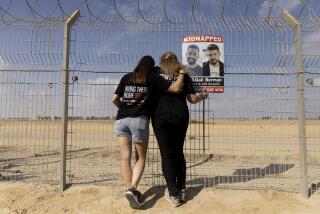Israelis Pull Together Despite Intifada and Other Strains
The first rays of light are emerging for an Israel beleaguered by uncertainty about the proper response to the Palestinian intifada , the growing power of Jewish Orthodox fundamentalists and a stagnant economy.
The past year has been one of the most difficult politically in Israelâs four turbulent decades. The Palestinian uprising caught the Israeli public by surprise and left political leaders groping for an appropriate policy. Initially, it was felt that a sufficiently strong show of force would end what in effect is a rebellion aimed at creating a state led by the Palestine Liberation Organization, a prospect most Israelis saw threatening their very existence. There was no significant Israeli political dimension. Diplomatic moves by the PLO, culminating in the Reagan Administrationâs decision to commence a diplomatic dialogue with Israelâs most vehement enemy, left Israelis defensive and wounded, believing they were fighting a civil war that many Americans instead saw as the Middle East equivalent of the American civil-rights movement of the â60s.
Reflecting public confusion about how to handle the intifada , the November elections continued a trend of chipping away at the moderate political middle. Over the past three national elections, in 1981, 1984 and 1988, Israelâs two major political parties, Labor and Likud, each lost eight seats in the Knesset to parties on their left and right flanks, respectively, leaving neither able to form a stable coalition itself.
The elections also underscored the threat to moderation in Israelâs religious affairs. In 1948, David Ben-Gurion reached a historic compromise with the Orthodox rabbinate, giving it a monopoly over major areas of personal life, such as marriage, divorce and conversion, with an implicit understanding that there would be a live-and-let-live attitude toward non-observant Israelis, about 80% of the population. This arrangement began to unravel in the 1980s along with the decline in political fortunes of the moderate National Religious Party, which supported the religious status quo.
Into the vacuum came insurgent, fundamentalist religious parties with a stunning increase in support in the 1988 elections, intent both on making secular Israel a more religious state and seeking to fight assimilation of American Jewry by changing the definition of âwho is a Jewâ to exclude from automatic Israeli citizenship those converted by the Reform and Conservative rabbis. In the process, both secular Israelis and large segments of American Jewry were upset.
Israelâs economy deteriorated in the wake of its political and religious problems. After remarkably pulling itself from the economic abyss in 1985, when inflation was running at 400% a year, Israel began to backslide. Inflation and unemployment rose and growth stagnated in 1988.
Now, there is growing evidence that Israel is pulling itself together on all threefronts--political, religious and economic. The middle is rallying. The two major parties, forced together by their own weaknesses, are beginning to coalesce around a sensible, moderate course to deal with the countryâs problems. There is a growing consensus among senior political and military leaders that only a political solution, and not military power, can solve the Palestinian problem. A recent political plan by Laborâs Defense Minister Yitzhak Rabin and new ideas being considered by Likud Prime Minister Yitzhak Shamir have common, hopeful elements. They recognize that there can be no returning to the status quo in the territories; that greater self-rule by the Palestinians is necessary; that Israelâs military presence in the territories can be redeployed if violence stops; that negotiations with indigenous Palestinians are essential; that the ultimate status of the territories should not be predetermined, and that Palestinian elections to select negotiating partners are feasible.
While these elements do not yet represent a full-blown Israeli government plan, and in any event will not meet maximalist--and unachievable--PLO demands (recognition of an independent Palestinian state by Israel and âthe right of returnâ for Palestinians living outside the West Bank and Gaza Strip), they nevertheless represent an important step forward. They provide a basis for the Bush Administration to help find Palestinian negotiators mutually acceptable to Israel and the PLO, a more realistic and achievable goal than an earlier American peace plan.
Similarly, the middle is reasserting itself in the religious area. Outrage by the Israeli public and by the American Jewish community ended the possibility of a coalition dominated by religious parties. The âwho is a Jewâ battle is in the deep freeze. Some of the new religious parties are opening a dialogue with non-Orthodox American Jews and view religious law as permitting flexibility in the political arena on the crucial issue of territorial concessions to the Palestinians.
Although last Novemberâs election was a disappointment for Labor leader Shimon Peres, who hoped to again become prime minister, he is now his own man as head of the powerful Finance Ministry. He has begun to take bold action to arrest Israelâs economic decline by cuts in the budget and in inefficient public subsidies, and he has plans for a series of exciting initiatives to privatize Israelâs heavily state-dominated economy and encourage greater foreign investment.
None of these suggest that Israel is out of the woods. Great problems remain. But moderates in both parties seem willing to work together to solve them in ways that are consistent with Israelâs tolerant, pluralistic democratic tradition. This can only be good news for Israel and its many friends in the Untied States.
More to Read
Sign up for Essential California
The most important California stories and recommendations in your inbox every morning.
You may occasionally receive promotional content from the Los Angeles Times.










